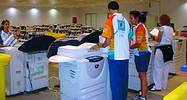Xerox on the starting blocks at the 2004 Olympics
1 October 2004
As the Athens 2004 Olympic games commenced, Xerox had assembled a force of over 230 engineers from 19 countries to handle the printing and publishing needs of the Games. To meet the Athens 2004 Olympic committee's guidelines, that results need to be recorded, tabulated and reported in hard copy to press, broadcasters, judges, Olympic officials, athletes, sponsors and Olympic staff, within five minutes of the completion of each event, Xerox has created significant infrastructure on site across the 35 competition venues and 26 non-competition venues and guarantee they will have a technician on site within only 10 minutes should a fault be reported, wherever it occurs across all 61 venues.

Main press office at the Olympics
To help fulfil this pledge, the Technical Operations Centre (TOC), was manned around the clock during the event. The TOC allowed Xerox technicians to monitor all networked devices, enabling Xerox to anticipate any issues that may have arisen and check or replace equipment before any problems actually occur.
Xerox is able to monitor all 6000 pieces of equipment through its CentreWare Network Services, which monitor and manage print and fax jobs. CentreWare acted as the central command centre providing information about all devices available on the network servers and jobs printed to those devices, including troubleshooting paper jams, deleting or holding print and fax jobs, and delivering the network device status of any piece of Xerox equipment installed in an Olympic location.
"The service levels in place, amount of equipment provided and ability of Xerox engineers to handle all the document needs for the Athens 2004 Olympic Games is a recognition of how critical the behind-the-scenes processes are to making the event run smoothly," says Vince Schaeffer, director, Worldwide Olympic Operations for Xerox. "The bottom line at events like this is that customers want to know that their systems will work when needed, and that there are systems in place to ensure near 100% availability. This is what we aimed to achieve for the full 17 days of the Olympic Games."
Throughout Xerox's 40-year relationship with the Olympics, the complexity of the document processing requirements has evolved dramatically. In 1964, during the Winter Olympic Games in Innsbruck, Austria, plain-paper copiers were used to print seven copies per minute. During the Summer Olympic Games in Greece in 2004, more than 6000 printers, copiers and multifunction machines supported over 120 million pages of printing, between 10 000 and 18 000 different reports throughout the 17 days.
For more information contact Sandy Soal, Bytes Document Solutions, 011 928 9111.
Others who read this also read these articles
Seven factors to consider when investing in a colour printer/copier
Proposals, presentations, even internal reports are being created and reproduced in colour to communicate messages more persuasively and with greater impact[ August 2002 ]
More than 70 years experience in engineering documentation
"Océ has built up a leading position on its markets worldwide by supplying products and services that are characterised by their high quality, reliability, productivity, durability, ease-of-use and environmental friendliness."[ August 2001 ]
MacDermid ColorSpan announces a new 12-head high-speed printer
"This printer is perfect for any company that needs high volume poster printing, because of its speed," says Ken Bezuidenhout, Managing Director of Protea Graphics.[ August 2001 ]
Océ provides solutions at EMS
The solutions will also assist EMS in achieving their primary business objective, ie concentrating on the core business of project management and thereby allow Océ to improve the efficiency and workflow of document reproduction[ April 2001 ]
When seeing is believing
The company's visual systems support the full range of commercial aircraft and are compatible with systems from all major flight simulator manufacturers[ Feb 2000 ]
Protea Graphics announces new wide inkjet printer
DisplayMaker Esprit is positioned to be the best value printer in its price class[ December 2000 ]
Printers receive positive feedback
Encad's channel partners have also reported high productivity and reliability for the NJ500 and NJ700 printing solutions, which were introduced along with the NovaJet 630 (NJ 630).[ June/July 2000 ]
Océ 8399 breaks price barrier ... for in-house, wide-format laser printing
With the Océ 9300, the quality and productivity of Océ LED printing is now available to users in medium and large engineering workgroups[ April/May 2000 ]
Others who read this also read these news items
Return of a classic
[ December 2005 ]
LAW Printing goes A1
[ December 2005 ]
White ink and clear varnish enhance images
[ December 2005 ]
New A0 colour scanner
[ December 2005 ]
UV curable inkjet printer
[ December 2005 ]
EFI Designer Edition - delivers quality projects
[ December 2005 ]
Wide format printing conquers the world
[ October 2005 ]
New generation of large-format inkjet printers
[ October 2005 ]
Search Site
Subscribe
Previous Issues
Other Technews Publications
Other Technews Buyers Guides
 |  | Copyright c1995-2009 Technews Publishing (Pty) Ltd.. All rights reserved. |